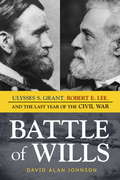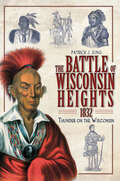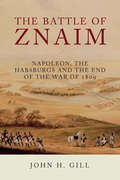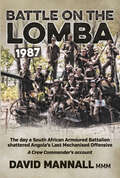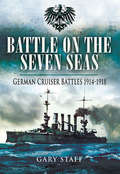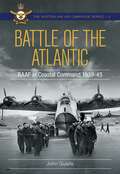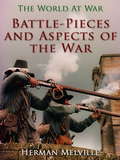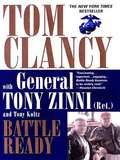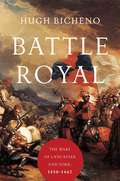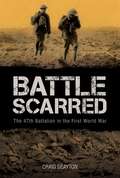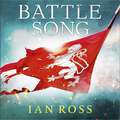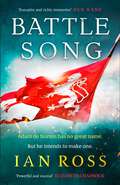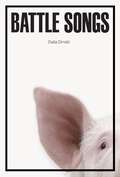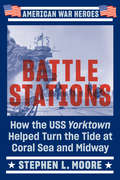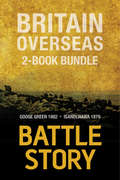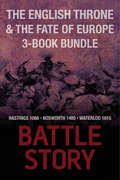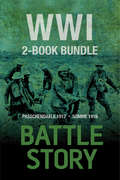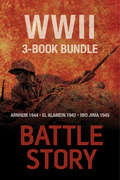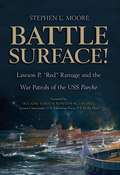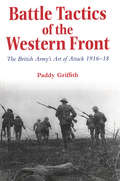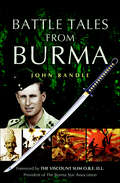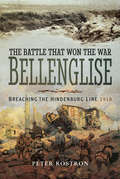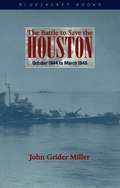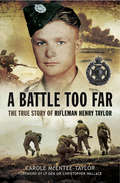- Table View
- List View
Battle of Wills: Ulysses S. Grant, Robert E. Lee, and the Last Year of the Civil War
by David Alan JohnsonHistorians have long analyzed the battles and the military strategies that brought the American Civil War to an end. Going beyond tactics and troop maneuvers, this book concentrates on the characters of the two opposing generals--Robert E. Lee and Ulysses S. Grant--showing how their different temperaments ultimately determined the course of the war. As author David Alan Johnson explains, Grant's dogged and fearless determination eventually gained the upper hand over Lee's arguably superior military brilliance. Delving into their separate upbringings, the book depicts Grant as a working-class man from Ohio and Lee as a Virginia aristocrat. Both men were strongly influenced by their fathers. Grant learned a lesson in determination as he watched his father overcome economic hardships to make a successful living as a tanner and leather goods dealer. By contrast, Lee did his best to become the polar opposite of his father, a man whose bankruptcy and imprisonment for unpaid debts brought disgrace upon the family. Lee cultivated a manner of unimpeachable respectability and patrician courtesy, which in the field of battle did not always translate into decisive orders. Underscoring the tragedy of this fratricidal conflict, the author recounts episodes from the earlier Mexican war (1846-1848), when Grant and Lee and many other officers who would later oppose each other were comrades in arms. This vivid narrative brings to life a crucial turning point in American history, showing how character and circumstances combined to have a decisive influence on the course of events.From the Hardcover edition.
The Battle of Wisconsin Heights, 1832: Thunder on the Wisconsin (War Era And Military Ser.)
by Patrick J JungThe story of a devastating episode of the brief, bloody Black Hawk War—includes illustrations. The brief war that Black Hawk waged against the United States in 1832 saw half of the people under his leadership killed in savage massacres and the entire Sauk tribe removed to Iowa. Yet this dismal outcome cannot obscure the superb military leadership that Black Hawk demonstrated during many phases of the war. His crowning glory occurred at a place called Wisconsin Heights, where his force of about 120 warriors held off an estimated 700 American militia volunteers while the women, children and elderly under his protection escaped across the Wisconsin River. This book tells the dramatic story and includes maps and illustrations.
The Battle of Znaim: Napoleon, the Habsburgs and the end of the War of 1809
by John H. GillThe acclaimed Napoleonic historian sheds new light on a fascinating yet little-known battle in the Franco-Austrian War.Occurring in July of 1809, the Battle of Znaim was the last to be fought on the main front of the Franco-Austrian War. Cut short to make way for an armistice it effectively ended hostilities between France and Austria and is now considered a unique episode of simultaneous conflict and diplomacy.The battle began as a result of the Austrian decision to stage a rearguard action near Znaim, prompting the Bavarians to unsuccessfully storm a nearby town. As the battle progressed over the course of the two days, the village changed hands a number of times.Historian John H. Gill delves into the tactics of both sides as the two armies continually changed positions and strategies. His account dissects and investigates the dual aspects of the Battle of Znaim and explains the diplomatic decisions that resulted in the peace treaty which was signed at Schonbrunn Palace on October 14th, 1809.
Battle on the Lomba 1987: A Crew Commander's Account
by David MannallA South African national serviceman recounts becoming a soldier and an ensuing David-and-Goliath face-off against Angolan armed forces in 1987.The climactic death-throes of Soviet Communism during the 1980s included a last-gasp attempt at strategic franchise expansion in southern Africa. Channeled through Castro’s Cuba, oil-rich Angolan armed forces (FAPLA) received billions of dollars of advanced weaponry and thousands of armored vehicles. Their intent: to eradicate the US-backed Angolan opposition (UNITA), then push southwards into South Africa’s protectorate SWA/Namibia, ostensibly as liberators.1985 saw the first large-scale mechanized offensive in southern African history. Russian Generals planned and oversaw the offensive but didn’t account for the tenacity of UNITA (supported by the South African Defense Forces, SADF) or the rainy season. The ‘85 offensive floundered in the mud, and FAPLA returned to their capital Luanda. The South Africans stood down, confident their “covert” support for UNITA had demonstrated the folly of prosecuting war so far from home against Africa’s military Superpower. However, they were mistaken. Fidel and FAPLA immediately redoubled their efforts, strengthening fifteen battalions with even more Soviet hardware while Russian and Cuban specialists oversaw troop training.As Cuban and Angolan fighter pilots honed their skills over the skies of Northern Angola, David Mannall, a normal seventeen-year-old kid completing high school, was preparing for two years of compulsory military service before beginning Tertiary education. Through a series of fateful twists, he found himself leading soldiers in several full-scale armored clashes, including the largest and most decisive battle on African soil since World War II.This is a David and Goliath story that has never been truthfully told. The author reveals how Charlie Squadron, comprising just twelve 90mm AFVs crewed by thirty-six national servicemen, as part of the elite sixty-one Mechanized Battalion, engaged and effectively annihilated the giant FAPLA 47th Armored Brigade in one day—3 October 1987. Their 90mm cannons were never designed as tank-killers, but any assurances that it would never be used against heavy armor were left in the classroom during the three-month operation and never more starkly than the decisive “Battle on The Lomba River.” The Communist-backed offensive died that day along with hundreds of opposition fighters.47th Brigade survivors abandoned their remaining equipment, eventually joining the 59th Brigade in what became a full-scale retreat of over ten thousand soldiers to Cuito Cuanevale. The myth perpetuated by post-apartheid politicians goes something like this: “The SADF force that destroyed 47th Brigade on 3 October numbered 6,000 men and that all the hard yards were run by the long-suffering UNITA!” The inconvenient truth is that there were just 36 South African boys on the frontline that day, but it is also true to say they would never have achieved such a stunning victory without the support of many more. This is their story.
Battle on the Seven Seas: German Cruiser Battles, 1914–1918
by Gary StaffThe cruisers of the Imperial German Navy (Kaiserlische Marine) were active throughout the First World War and saw action all around the globe, tying up valuable Allied naval resources out of all proportion to their number. Drawing on firsthand accounts and original research in German archives, the author here describes in detail some of their most significant and/or audacious battles.Some are well known, such as their role at Jutland, Goeben's attack on the Russian fleet (which brought Turkey into the war) and the sagas of Konigsberg and Emden; but others have been unduly neglected. Gary Staff deliberately focuses on the latter to bring new material to the attention of the reader and to demonstrate the global span of the cruisers' activities. The blow-by-blow accounts of the action (drawing heavily on firsthand Allied and especially German accounts) are supported by dozens of photographs, many previously unpublished, from the author's own impressive collection.The battles described include: Helgoland Bight, August 1914; Coronel, November 1914; Falklands December, 1914; Doggerbank, January 1915; Goeben and the Russian fleet, Black Sea, May 1915; Ostergarn July 1915; Jutland, 1916; Second Heligoland Bight, November 1917; Imbros, January 1918.
Battle over the Atlantic: Royal Australian Air Force in Coastal Command 1939-1945
by John QuaifeAt the outbreak of World War II, somewhat by accident — and just as the first shots of the war were fired — young Australian airmen from the Royal Australian Air Force were engaged in operations that would become known collectively as the Battle of the Atlantic. Arguably lesser-known than air campaigns in other theatres, large numbers of Australians who volunteered for service with Royal Australian Air Force, found themselves fighting in this battle. Australians were there at the outbreak and many would go on to fly some of the final missions of the war in Europe. This book captures some of the experiences of the Royal Australian Air Force members who served with Coastal Command and, through the weight of numbers alone, stories of the Sunderland squadrons and the Battle of the Atlantic dominate the narrative. Being critical to Britain&’s survival, the battle also dominated Coastal Command throughout the war but Australians served in a surprising variety of other roles. The nature of many of those tasks demanded persistence that could only be achieved by large numbers of young men and women being prepared to &‘do what it took&’ to get a tedious and unrewarding job done. Over 400 did not come home.
Battle-Pieces and Aspects of the War: Civil War Poems (The World At War)
by Herman MelvilleBattle-Pieces and Aspects of the War (1866) is the first book of poetry published by American author Herman Melville. The volume is dedicated "To the Memory of the Three Hundred Thousand Who in the War For the Maintenance of the Union Fell Devotedly Under the Flag of Their Country" and its 72 poems deal with the battles and personalities of the American Civil War and their aftermath. (Excerpt from Wikipedia)
Battle Ready
by Tony Zinni Tom Clancy Tony KoltzMarine general Tony Zinni was known as the "Warrior Diplomat" during his nearly forty years of service. His credentials as a soldier were impeccable, whether he was leading troops in Vietnam, commanding hair-raising rescue operations in Somalia, or - as Commander in Chief of CENTCOM - directing strikes against Iraq and Al Qaeda. But it was as a peacemaker that he made just as great a mark - conducting dangerous troubleshooting missions all over Africa, Asia, and Europe, and then serving as Secretary of State Colin Powell's special envoy to the Middle East, before disagreements over the 2003 Iraq war and its probable aftermath caused him to resign." Battle Ready follows the evolution of both General Zinni and the Marine Corps, from the cauldron of Vietnam through the operational revolution of the '70s and '80s, to the new realities of the post-Cold War, post-9/11 military - a military with a radically different tools for accomplishing it. Opinions differ sharply about just what that job and those tools should be - and General Zinni makes it clear where he stands.
Battle Royal: 1440-1462 (The\wars Of Lancaster And York Ser. #01)
by Hugh BichenoThe enthralling story of the dynastic wars fought between the houses of Lancaster and York, the first of a dynamic two-volume history of the Wars of the Roses. England, 1454. A kingdom sliding into chaos. The mentally unstable King Henry VI, having struggled for a decade to contain the violent feuding of his dukes, is losing his mind. Disgruntled nobles support the regal claims of Richard, Duke of York, great-grandson of Edward III. The stage is set for civil war. The first volume of an enthralling two-part history of the dynastic wars fought between the houses of Lancaster and York, Battle Royal traces the conflict from its roots in the 1440s to the early 1460s—a period marked by the rise and fall of Richard of York, the deposition of Henry VI following the Lancastrian defeat at Towton, and the subsequent seizure of his throne by Richard's son Edward. Populating this late-medieval saga of ambition, intrigue, and bloodshed are such fascinating characters as the vacillating Henry VI himself, his indefatigable queen Marguerite of Anjou, Richard of York (father of kings but never king himself), his opportunist ally Richard Neville—"the Kingmaker"—and the precociously virile Edward of York. Charting a clear course through the dynastic complexities of fifteenth-century power politics, and offering crisply authoritative analysis of the key battles of the Wars of the Roses, Battle Royal is a dynamic and rigorously researched account of England's longest and bloodiest civil war.
Battle Scarred: The 47th Battalion in the First World War
by Craig Deayton"The dead and wounded of the 47th lay everywhere underfoot". With these words Charles Bean, Australia's Official War Historian, described the battlefield of Dernancourt on the morning of the 5th of April, 1918, strewn with the bodies of the Australian dead. It was the final tragic chapter in the story of the 47th Australian Infantry Battalion in the First World War. One of the shortest lived and most battle hardened of the 1st Australian Imperial Force's battalions, the 47th was formed in Egypt in 1916 and disbanded two years later having suffered one of the highest casualty rates of any Australian unit. Their story is remarkable for many reasons. Dogged by command and discipline troubles and bled white by the desperate attrition battles of 1916 and 1917, they fought on against a determined and skilful enemy in battles where the fortunes of war seemed stacked against them at every turn. Not only did they have the misfortune to be called into some of the A.I.F.'s most costly campaigns, chance often found them in the worst places within those battles. Though their story is one of almost unrelieved tragedy, it is also story of remarkable courage, endurance and heroism. It is the story of the 1st A.I.F. itself - punished, beaten, sometimes reviled for their indiscipline, they fought on - fewer, leaner and harder - until final victory was won. And at its end, in an extraordinary gesture of mateship, the remnants of the 47th Battalion reunited. Having been scattered to other units after their disbandment, the survivors gathered in Belgium for one last photo together. Only 73 remained.
Battle Song: The 13th century historical adventure for fans of Bernard Cornwell and Ben Kane (de Norton trilogy)
by Ian Ross'There is a fury in England that none shall suppress - and when it breaks forth it will shake the throne'1264 Storm clouds are gathering as Simon de Montfort and the barons of the realm challenge the power of Henry III. The barons demand reform; the crown demands obedience. England is on the brink of civil war. Adam de Norton, a young squire devoted to the virtues of chivalry, longs only to be knighted, and to win back his father's lands. Then a bloody hunting accident leaves him with a new master: the devilish Sir Robert de Dunstanville, who does not hesitate to use the blackest stratagems in pursuit of victory. Following Robert overseas, Adam is introduced to the ruthless world of the tournament, where knights compete for glory and riches, and his new master's methods prove brutally effective. But as England plunges into violence, Robert and Adam must choose a side in a battle that will decide the fate of the kingdom. Will they fight for the king, for de Montfort - or for themselves? Searingly vivid and richly evocative, Battle Song is tale of friendship and chivalry, rivalry and rebellion, and the medieval world in all its colour and darkness.(P) 2023 Hodder & Stoughton Limited
Battle Song: The 13th century historical adventure for fans of Bernard Cornwell and Ben Kane (de Norton trilogy)
by Ian Ross'A very promising historical adventure' - THE TIMES***'There is a fury in England that none shall suppress - and when it breaks forth it will shake the throne'1264 Storm clouds are gathering as Simon de Montfort and the barons of the realm challenge the power of Henry III. The barons demand reform; the crown demands obedience. England is on the brink of civil war. Adam de Norton, a young squire devoted to the virtues of chivalry, longs only to be knighted, and to win back his father's lands. Then a bloody hunting accident leaves him with a new master: the devilish Sir Robert de Dunstanville, who does not hesitate to use the blackest stratagems in pursuit of victory. Following Robert overseas, Adam is introduced to the ruthless world of the tournament, where knights compete for glory and riches, and his new master's methods prove brutally effective. But as England plunges into violence, Robert and Adam must choose a side in a battle that will decide the fate of the kingdom. Will they fight for the king, for de Montfort - or for themselves? Searingly vivid and richly evocative, Battle Song is tale of friendship and chivalry, rivalry and rebellion, and the medieval world in all its colour and darkness.
Battle Song: The 13th century historical adventure for fans of Bernard Cornwell and Ben Kane (de Norton trilogy)
by Ian Ross'A very promising historical adventure' - THE TIMES'A terrific novel' - HISTORIA MAGAZINE***'There is a fury in England that none shall suppress - and when it breaks forth it will shake the throne'1264 Storm clouds are gathering as Simon de Montfort and the barons of the realm challenge the power of Henry III. The barons demand reform; the crown demands obedience. England is on the brink of civil war. Adam de Norton, a young squire devoted to the virtues of chivalry, longs only to be knighted, and to win back his father's lands. Then a bloody hunting accident leaves him with a new master: the devilish Sir Robert de Dunstanville, who does not hesitate to use the blackest stratagems in pursuit of victory. Following Robert overseas, Adam is introduced to the ruthless world of the tournament, where knights compete for glory and riches, and his new master's methods prove brutally effective. But as England plunges into violence, Robert and Adam must choose a side in a battle that will decide the fate of the kingdom. Will they fight for the king, for de Montfort - or for themselves? Searingly vivid and richly evocative, Battle Song is tale of friendship and chivalry, rivalry and rebellion, and the medieval world in all its colour and darkness.***Readers absolutely love BATTLE SONG:'Another five star Ian Ross novel!' *****'Truly is a masterclass in historical fiction' *****'The best historical fiction I've read in years. Up there with Hilary Mantel!' *****'A great well researched novel' *****'Brilliantly researched, gorgeously plotted and blessed with a terrific cast of exquisitely drawn characters' *****'Well written and engaging characters' *****'Ian Ross writes with a class and style that leaves the reader or listener thirsting for more' *****'Brilliantly researched, gorgeously plotted and blessed with a terrific cast of exquisitely drawn characters' *****'A gripping tale of early England' *****'A really good story, brought to life by an excellent narrator' *****
Battle Songs
by Daša DrndicAn early novel from the masterful Drndic, Battle Songs is an intimate, ferocious account of her years spent as a refugee in Canada during the Yugoslav Wars In the 1990s, the unnamed narrator of Battle Songs leaves Yugoslavia with her daughter Sara to Toronto to start a new life. They, along with other refugees, encounter a new country but not a new home. Book editors sell hotdogs, mathematicians struggle to get by on social security, violinists hawk cheap goods on the street. Years after arriving in Canada, when she thinks no one can hear her, Sara still sings in the shower: What can we do to make things better, what can we do to make things better, la-la-la-la. In true Drndic style, the novel has no one time or place. It is interspersed with stories from the Yugoslav Wars, from Rijeka to Zagreb to Sarajevo—with, as always, the long shadow of the Second World War looming overhead. Her singular layering of details—from lung damage to silk scarves to the family budget to old romances—offers an almost unbearable closeness to the characters and their moment in history. “Wry and kindly, funny, angry, informed and intent on the truth, no voice is quite as blisteringly beautiful as that of Drndic” (Financial Times).
Battle Stations: How the USS Yorktown Helped Turn the Tide at Coral Sea and Midway (American War Heroes)
by Stephen L. MooreThe true story of the valiant men who gave their all to save the aircraft carrier USS Yorktown—and changed the course of the Pacific War. On June 4, 1942—six months after the attack on Pearl Harbor—Yorktown&’s crew began the carrier&’s final battle against Japan&’s infamous aircrafts. Hotshot fighter pilot Lieutenant Scott McCuskey attacked from the air in his Wildcat, becoming the Navy&’s second-ever &“ace in a day.&” Carpenter Boyd McKenzie worked tirelessly to repair Yorktown before a fresh air strike. Critically injured gun crew member George Weise fought for his life as the ship threatened to capsize. Meanwhile, Pharmacist&’s Mate Second Class Warren Heller raced to save the lives of bloodied gunners and sailors by evacuating them before time ran out. The stories of these heroes and many other brave servicemen bring the gripping narrative of Yorktown&’s final thirty days to life, as she fights in the near back-to-back Battles of Coral Sea and Midway. Through unpublished memoirs and interviews with Yorktown&’s last surviving veterans, acclaimed author Stephen L. Moore offers up a new and compelling amount of a pivotal month in World War II, while honoring the courage of those who served.
Battle Stories — Britain Overseas 2-Book Bundle: Goose Green 1982 / Isandlwana 1879
by Edmund Yorke Gregory Fremont-BarnesTwo pivotal moments in British military history, separated by more than a century, yet both with decisive impacts on Britain’s national identity and power overseas. At Isandlwana, South Africa, as at Goose Green in the Falkland Islands, British commanders underestimated local forces and found themselves unprepared for the full extent of combat on the ground. One engagement ended in disaster and a total rethinking of tactics. The other, thanks to hard lessons learned, ended in British victory. Two renowned experts tell the full stories of both battles, complete with detailed profiles of key figures and a moment-to-moment breakdown of history in the making. Isandlwana 1879 On January 22, 1879, a 20,000-strong Zulu army attacked 1,700 British and colonial forces. The engagement saw primitive weapons of spears and shields clashing with the latest military technology. However, despite being poorly equipped, the numerically superior Zulu force crushed the British troops, killing 1,300 men, while only losing 1,000 of their own warriors. It was a humiliating defeat for the British Army, which had been poorly trained and which had underestimated its enemy. The defeat ensured that the British had a renewed respect for their opponents and changed their tactics; rather than fighting in a straight, linear formation, known as the Thin Red Line, they adopted an entrenched system or close order formations. The defeat caused much consternation throughout the British Empire, which had assumed that the Zulu were no match for the British Army; thus, the army was greatly reinforced and went on to victory at Rorke’s Drift. Isandlwana 1879 puts you at the forefront of the action. Goose Green 1982 The Battle for Goose Green has become an integral part of the Falklands story, and yet it nearly didn’t take place at all. Originally earmarked to be isolated, Goose Green was eventually attacked due to the loss of momentum in the invasion force. The British 2 Para Regiment were deployed against the 12th Argentinean Regiment, which numbered about 1,200 men. The British believed that the Argentinean force numbered at least half this and set off with a strength of 690 men. They took two days’ rations, weapons, and ammunition in the belief that it would be a swift conquest. There followed a bitter and bloody fight as the Argentine forces fiercely defended Goose Green. Despite reconnaissance, the British were hampered by trench systems that they had been unaware of. It was the first major engagement of the Falklands War.
Battle Stories — The English Throne and the Fate of Europe 3-Book Bundle: Hastings 1066 / Bosworth 1485 / Waterloo 1815
by Mike Ingram Jonathan Trigg Gregory Fremont-BarnesThree battles that shook the British Isles and changed the course of world history. Three renowned experts each take up one crucial day when the future of the throne, or Europe itself, hung in the balance. Hastings 1066 In 1066, a foreign invader won the throne of England in a single battle and changed not only the history of the British Isles, but that of Christendom, forever. Harold Godwinson’s army, exhausted from their victory against an invading Norwegian Viking army at the Battle of Stamford Bridge in the north, and his navy, scattered by storms, could not hold back William of Normandy. But would the invasion have succeeded if the two armies had met on equal terms? Bosworth 1485 Bosworth Field saw the two great dynasties of the day clash on the battlefield: the reigning House of York, led by Richard III, and the rising House of Tudor, led Henry Tudor, soon to become Henry VII. On August 22, 1485, this penultimate battle in the Wars of the Roses was fought with the might of the Yorkists ranged against Tudor’s small army. This book describes how these two great armies came to meet on the battlefield, and how the Tudor tactics eventually led to the downfall and death of King Richard III. Waterloo 1815 The might of the French Empire under the leadership of the Emperor Napoleon faced the Coalition army under Duke of Wellington and Gerhard von Blucher for one last time at Waterloo. The battle saw the culmination of a long campaign to destroy Napoleon’s forces and halt the growth of the French Empire. Both armies lost over 20,000 men on the battlefield that day, but it was the coalition that emerged victorious in the end. Wellington’s counter-attack threw the French troops into disarray, a resounding victory for the British Army that changed the course of European history.
Battle Stories — WWI 2-Book Bundle: Somme 1916 / Passchendaele 1917
by Chris Mcnab Andrew RobertshawDiscover two pivotal battles of the First World War in this collection of Battle Stories. Somme 1916 The Battle of the Somme was one of the bloodiest fought in military history. It has come to signify for many the waste and bloodshed of the First World War, as hundreds of thousands of men on all sides lost their lives fighting over small gains in land. Yet this battle was also to mark a turning point in the war and to witness new methods of warfare. In this Battle Story, Andrew Robertshaw seeks to lift the battle out of its controversy and explain what really happened and why. Passchendaele 1917 Passchendaele is perhaps one of the most iconic campaigns of the First World War, coming to symbolize the mud and blood of the battlefield like no other. Fought for over three months under some of the worst conditions of the war, fighting became bogged down in a quagmire that made it almost impossible for any gains to be made.
Battle Stories — The WWII 3-Book Bundle: El Alamein 1942 / Arnhem 1944 / Iwo Jima 1945
by Andrew Rawson Pier Paolo Battistelli Chris BrownThree battles that changed the course of WWII and echo through world history to the present day. Three renowned experts each take up one of these crucial engagements. Iwo Jima 1945 Operation Detachment, the invasion of Iwo Jima, on February 19, 1945, was the first campaign on Japanese soil, and it resulted in some of the fiercest fighting of the Pacific campaign. El Alamein 1942 El Alamein saw two of the greatest generals of the war pitted against each other: Rommel and Montgomery. Arnhem 1944 When we think of Arnhem, we think of a bridge too far and a sky full of parachutes dropping the Allies into the Netherlands. It was one of the most complex and strategically important operations of the war.
Battle Surface!
by Stephen L. MooreCmdr. Lawson Paterson Red Ramage was among an elite group of just seven U.S. submariners who were awarded the Medal of Honor during World War II and the first not to die in the course of his heroic exploits. He was honored for his actions in the Pacific on the night of 31 July 1944 when he kept his submarine, USS Parche, on the surface and defiantly charged into the midst of a large Japanese convoy. Ramage's close-in, furious surface rampage became the talk of the submarine force, both in terms of its boldness and its destruction of the enemy shipping. Remarkably, Parche's crew had managed to reload their torpedo tubes while their skipper twisted and turned the boat through the chaos of machine gun bullets, exploding heavy shells, and Japanese ships trying to ram them.To tell Parche's dramatic story, author Stephen Moore draws on recently discovered wartime diaries and interviews with dozens of veterans, who add rich details to the official record. Readers learn what it was like on patrol in the Pacific to endure the terrors of torpedo attacks and depth charges, as well as learn how they relieved the stress of combat on liberty. The only book to focus exclusively on Parche and the incredible Red Ramage, it offers a rare, up-close look at the actions of the legendary World War II submarine, whose conning tower and periscopes are on permanent display in Pearl Harbor.
Battle Tactics of the Western Front
by Paddy GriffithHistorians have portrayed British participation in World War I as a series of tragic debacles, with lines of men mown down by machine guns, with untried new military technology, and incompetent generals who threw their troops into improvised and unsuccessful attacks. In this book a renowned military historian studies the evolution of British infantry tactics during the war and challenges this interpretation, showing that while the British army's plans and technologies failed persistently during the improvised first half of the war, the army gradually improved its technique, technology, and, eventually, its' self-assurance. By the time of its successful sustained offensive in the fall of 1918, says Paddy Griffith, the British army was demonstrating a battlefield skill and mobility that would rarely be surpassed even during World War II.Evaluating the great gap that exists between theory and practice, between textbook and bullet-swept mudfield, Griffith argues that many battles were carefully planned to exploit advanced tactics and to avoid casualties, but that breakthrough was simply impossible under the conditions of the time. According to Griffith, the British were already masters of "storm troop tactics" by the end of 1916, and in several important respects were further ahead than the Germans would be even in 1918. In fields such as the timing and orchestration of all-arms assaults, predicted artillery fire, "Commando-style" trench raiding, the use of light machine guns, or the barrage fire of heavy machine guns, the British led the world. Although British generals were not military geniuses, says Griffith, they should at least be credited for effectively inventing much of the twentieth-century's art of war.
Battle Tales from Burma
by John RandleA collection of autobiographical stories from an officer in the British Indian Army during World War II. John Randle served with the greatly respected Baluch Regiment of the former Indian Army right through the fiercely fought Burma Campaign, winning a Military Cross, yet on VJ Day he was only some sixty miles from where had started out nearly four years before. Unlike other conventional war memoirs, this book comprises a gratifying number of self-contained stories drawn from the author&’s experiences and memories. Some are long, other mere vignettes; some are moving and serious, others are light-hearted even humorous. Some cover hard-won victories and success, others defeats and reversal; some describe acts of great valor, others incidents reflecting human frailties. All however, are worth reading and give a very accurate picture of war at its bitterest, when men are drawn together and individuals are under that most demanding microscope of their fellow comrades-in-arms.
The Battle That Won the War: Breaching the Hindenburg Line, 1918
by Peter RostronIt is no exaggeration to claim that 46th North Midland Divisions action on 29 September 1918 was the hammer blow that shattered the will of the German High Command.Painting the strategic picture from early 1918 and the dark weeks following the Germans March offensive, the Author lays the ground for the Allied counter-strike. Ahead of them was the mighty Hindenburg Line, the Kaisers formidable defensive obstacle given added strength by the St Quentin Canal.Undaunted the Allies attacked using American, Australian and British formations. Led by Major General Boyd, 46 Division stormed the Canal and, thanks to a combination of sound planning and determined courageous fighting, seized their Hindenburg Line objective by the end of the day.The psychological damage to the German will, already weakened by the failure of the Spring offensive, is demonstrate by Ludendorffs collapse and opening of negotiations that led five weeks later to the Armistice.
The Battle to Save the Houston
by John Grider MillerA World War II adventure story of epic proportions, this book tells the heroic tale of a dedicated band of men who refused to let their crippled ship sink to the bottom of the Pacific in late 1944. Based on over seventy eyewitness accounts and hundreds of official documents and personal papers, it records in rich detail the USS Houston's 14,000-mile perilous journey home to the Brooklyn Navy Yard. Part of Bull Halsey's famous Pacific Task Force 38, the Houston's had been supporting air strikes as a prelude to the Battle of Leyte Gulf, when she took an aerial torpedo hit that caused serious flooding. Nearly two-thirds of the crew abandoned ship before the damage-control officer convinced the captain she might be saved. Another torpedo hit two days later complicated the crew's desperate fight. Surrounded by death, floodwaters, and fire, stalked by enemy subs, threatened by air attack, and running from a typhoon, the men of the Houston's remained towers of strength while knowing their ship was never more than minutes away from breaking apart. John Miller's action-packed account gives insights into the nature of heroism and leadership that remain valuable today. Exceptional photographic documentation accompanies the text
A Battle Too Far: The True Story of Rifleman Henry Taylor
by Carole McEntee-TaylorA British Army veteran’s harrowing experiences in Europe and Africa during World War II are recounted in this gripping biography.A Battle Too Far is the true story of Rifleman Henry Taylor 6923581, late 7th Battalion The Rifle Brigade (1st Battalion London Rifle Brigade) and is based on his diaries and recollections as told to his son Lawrence. The Foreword is by Lt-Gen Sir Christopher Wallace Chairman of The Royal Green Jackets (Rifles) Museum in Winchester.Henry’s war began in October 1942 as the 2nd Battle of El Alamein commenced and continued almost non-stop for the next three years. From El Alamein to Tunisia, he fought with the 8th Army as they finally pushed Rommel back to the sea. Although they expected to return to Britain in preparation for D Day, plans were changed at the last minute, and they were ordered to Italy instead. Here they found themselves fighting for every inch of land against determined, well dug-in defenders, in conditions often resembling the trenches of World War I. Their reward? Their campaigns forgotten as the world concentrated on the D Day invasion, and to be called “D Day Dodgers” despite enduring some of the heaviest fighting of the war.As Europe celebrated VE Day, Henry’s war continued as they raced to Austria to prevent Yugoslav forces annexing Carinthia in the opening shots of the Cold War. Then, as the men around him were de-mobbed, Henry and the rest of the Battalion were sent back to Egypt to protect British interests in the continuing civil unrest. They felt dejected and fed up, so it only took one incident to spark a mutiny . . .
